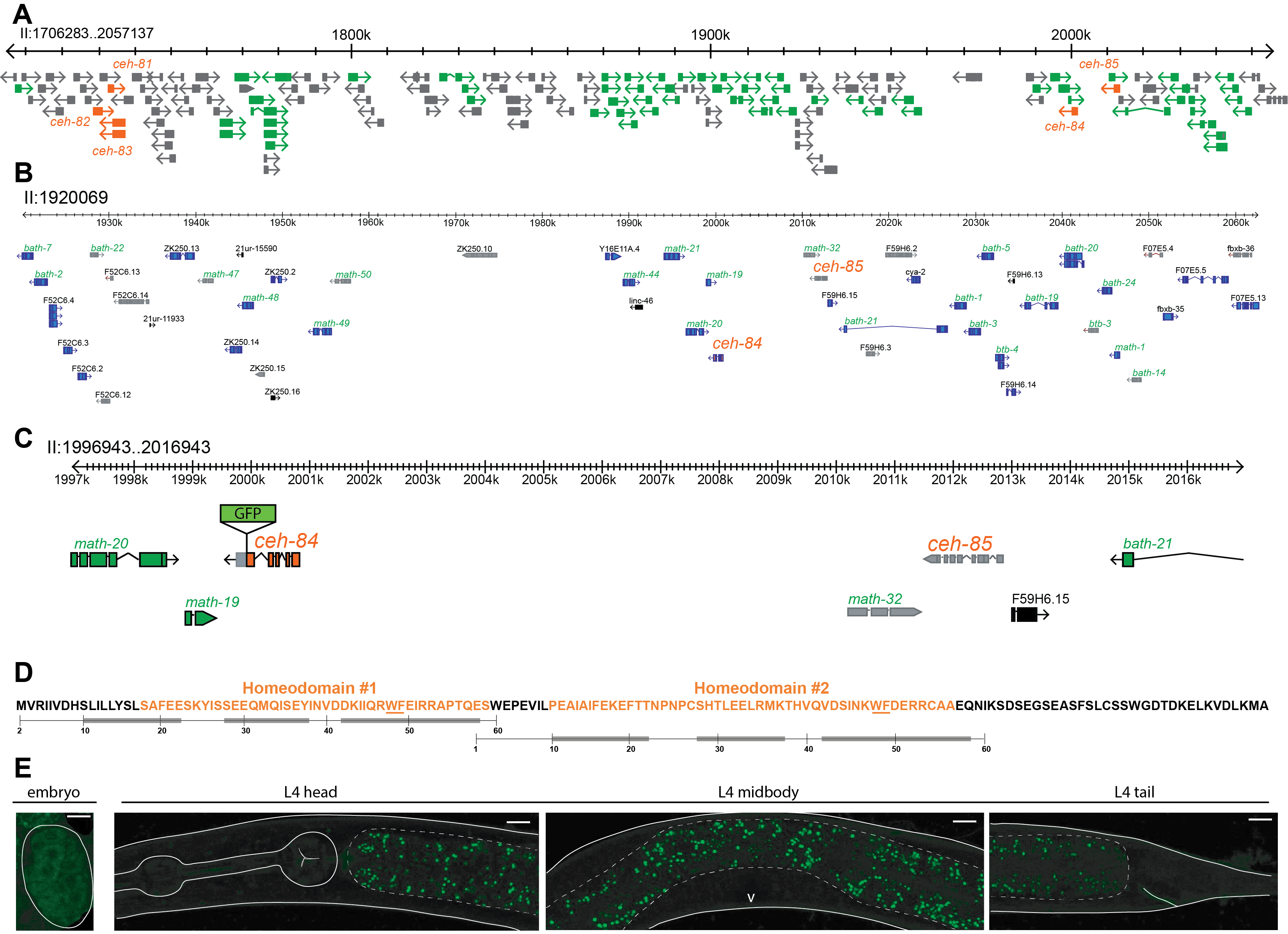Howard Hughes Medical Institute
Description
We have previously described the expression patterns of all but one of the 102 homeobox genes present in the C. elegans genome, using either fosmid-based reporter transgenes or CRISPR/Cas9-engineered gfp reporter alleles (Reilly et al., 2020). The last remaining homeobox gene for which we were initially not able to generate a reporter reagent is ceh-84 (Reilly et al., 2020). As previously recognized by Thomas Bürglin (Hench et al., 2015), ceh-84 codes for an unusual homeodomain protein with two divergent homeodomains (Fig.1D). It likely is a tandem duplicate of the ceh-85 gene, which has been classified as a pseudogene (Fig.1B). ceh-84 has no recognizable homologs in other Caenorhabditis species (Hench et al., 2015). Together with its duplicate, ceh-85, it localizes to a large cluster of extensively duplicated genes on chromosome II, described by James Thomas (Thomas, 2006). Most of the duplicated genes code for MATH and BTB type proteins (Fig.1A). The entire cluster seems to be C. elegans-specific (Thomas, 2006) and, apart from a number of pseudogenes, it also contains the C. elegans-specific ceh-81, ceh-82 and ceh-83 homeobox genes (Fig.1A).
We designed a gfp reporter allele of ceh-84 that was generated by CRISPR/Cas9 genome engineering. We observed no expression of the protein in any cells in larvae and adults (Fig.1E). In embryos we observe very dim, diffuse GFP signals that make it unlikely that any functional protein is present in the nucleus at any stage. The absence of obvious CEH-84 in the mature nervous system is consistent with our previously reported observation that nematode or C. elegans-specific homeobox genes make no significant contribution to the combinatorial code of homeobox gene expression in the nervous system (Reilly et al., 2020).
Reagents
PHX2811 – ceh-84(syb2811[ceh-84::GFP]). Generated and provided by Sunybiotech.
Methods
Request a detailed protocolFor imaging, worms were anesthetized using 100mM of sodium azide (NaN3) and mounted on 5% agarose pad on glass slides. Images were acquired at 40x using a confocal laser scanning microscope (Zeiss LSM880) and processed using the ImageJ software. Representative maximum intensity projections are shown for GFP channel as gray scale and gamma and histogram were adjusted for visibility.
References
Funding
This work was funded by a predoctoral fellowship to Molly Reilly (F31 NS105398), by NIH R21 NS106843, and by the Howard Hughes Medical Institute
Reviewed By
AnonymousHistory
Received: November 11, 2020Revision received: December 18, 2020
Accepted: December 1, 2020
Published: December 1, 2020
Copyright
© 2020 by the authors. This is an open-access article distributed under the terms of the Creative Commons Attribution 4.0 International (CC BY 4.0) License, which permits unrestricted use, distribution, and reproduction in any medium, provided the original author and source are credited.Citation
Reilly, M; Hobert, O (2020). ceh-84, an unusual homeobox gene. microPublication Biology. 10.17912/micropub.biology.000340.Download: RIS BibTeX




